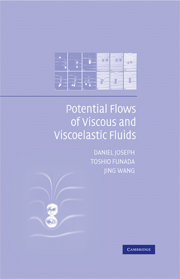Book contents
- Frontmatter
- Contents
- Preface
- List of Abbreviations
- 1 Introduction
- 2 Historical notes
- 3 Boundary conditions for viscous fluids
- 4 Helmholtz decomposition coupling rotational to irrotational flow
- 5 Harmonic functions that give rise to vorticity
- 6 Radial motions of a spherical gas bubble in a viscous liquid
- 7 Rise velocity of a spherical cap bubble
- 8 Ellipsoidal model of the rise of a Taylor bubble in a round tube
- 9 Rayleigh–Taylor instability of viscous fluids
- 10 The force on a cylinder near a wall in viscous potential flows
- 11 Kelvin–Helmholtz instability
- 12 Energy equation for irrotational theories of gas–liquid flow: viscous potential flow, viscous potential flow with pressure correction, and dissipation method
- 13 Rising bubbles
- 14 Purely irrotational theories of the effect of viscosity on the decay of waves
- 15 Irrotational Faraday waves on a viscous fluid
- 16 Stability of a liquid jet into incompressible gases and liquids
- 17 Stress-induced cavitation
- 18 Viscous effects of the irrotational flow outside boundary layers on rigid solids
- 19 Irrotational flows that satisfy the compressible Navier–Stokes equations
- 20 Irrotational flows of viscoelastic fluids
- 21 Purely irrotational theories of stability of viscoelastic fluids
- 22 Numerical methods for irrotational flows of viscous fluid
- Appendix A Equations of motion and strain rates for rotational and irrotational flow in Cartesian, cylindrical, and spherical coordinates
- Appendix B List of frequently used symbols and concepts
- References
- Index
22 - Numerical methods for irrotational flows of viscous fluid
Published online by Cambridge University Press: 09 October 2009
- Frontmatter
- Contents
- Preface
- List of Abbreviations
- 1 Introduction
- 2 Historical notes
- 3 Boundary conditions for viscous fluids
- 4 Helmholtz decomposition coupling rotational to irrotational flow
- 5 Harmonic functions that give rise to vorticity
- 6 Radial motions of a spherical gas bubble in a viscous liquid
- 7 Rise velocity of a spherical cap bubble
- 8 Ellipsoidal model of the rise of a Taylor bubble in a round tube
- 9 Rayleigh–Taylor instability of viscous fluids
- 10 The force on a cylinder near a wall in viscous potential flows
- 11 Kelvin–Helmholtz instability
- 12 Energy equation for irrotational theories of gas–liquid flow: viscous potential flow, viscous potential flow with pressure correction, and dissipation method
- 13 Rising bubbles
- 14 Purely irrotational theories of the effect of viscosity on the decay of waves
- 15 Irrotational Faraday waves on a viscous fluid
- 16 Stability of a liquid jet into incompressible gases and liquids
- 17 Stress-induced cavitation
- 18 Viscous effects of the irrotational flow outside boundary layers on rigid solids
- 19 Irrotational flows that satisfy the compressible Navier–Stokes equations
- 20 Irrotational flows of viscoelastic fluids
- 21 Purely irrotational theories of stability of viscoelastic fluids
- 22 Numerical methods for irrotational flows of viscous fluid
- Appendix A Equations of motion and strain rates for rotational and irrotational flow in Cartesian, cylindrical, and spherical coordinates
- Appendix B List of frequently used symbols and concepts
- References
- Index
Summary
Problems of potential flow in irregular domains bounded by rigid solids and satisfying perhaps conditions at infinity require numerical methods. Computers and software are now so powerful that it can be easier to compute a solution than to find the exact one in a reference book. There are many techniques that may be used to solve Laplace's equation with prescribed boundary conditions. These techniques are readily available even in “search” on the web.
The numerical simulation of the deformation of interfaces between two immiscible fluids or in gas–liquid flows is currently an active topic of research and many options are available for researchers. Level-set methods associated with the names of S. Osher, R. Fedkiw, and J. Sethian, volume-of-fluid methods associated with the name of S. Zaleski, and front-tracking methods associated with the name of G. Trygvasson, are high among the most popular methods. Readers can find references in the comprehensive reviews by Yeung (1982), Tsai and Yue (1996), and Scardovelli and Zaleski (1999), or in “search” on Google.
Perturbation methods
The problem of numerical simulation of the shape of free surfaces in potential flows of inviscid fluids has been considered by various authors. Perturbation methods for nonlinear irrotational waves on an inviscid fluid were introduced by Stokes (1847). He expanded the solution in powers of the amplitude.
- Type
- Chapter
- Information
- Potential Flows of Viscous and Viscoelastic Liquids , pp. 461 - 464Publisher: Cambridge University PressPrint publication year: 2007

